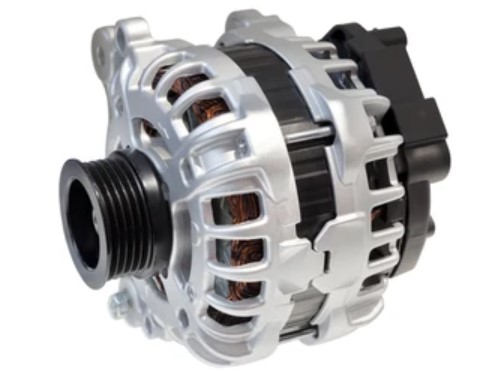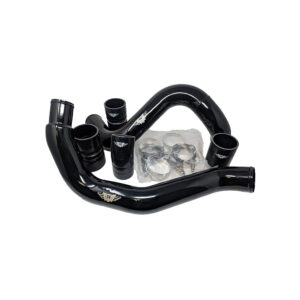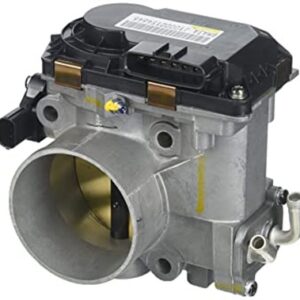Alternator
The High Output Alternator stands as a vital component beneath the hood, resembling a compact cylindrical generator securely bolted to the engine.
Serving as a cornerstone within a vehicle’s electric charging system, the alternator collaborates with the battery and voltage regulator. Its primary role is to furnish electrical power for storage in the vehicle’s battery.
Operating seamlessly, it harnesses mechanical power from a drive or serpentine belt linked to the engine’s crankshaft pulley, skillfully transforming this mechanical force into a reliable source of electricity.
The alternator’s prowess lies not only in its functionality but also in its cost-effectiveness, embodying efficiency without compromising on quality.
Experience optimal performance and durability with our cutting-edge alternator, ensuring a dependable power supply for your vehicle.
$850.00
CompareAlternator
The alternator is a vital component of a vehicle’s electrical system, responsible for generating electrical power and charging the battery while the engine is running. It converts mechanical energy from the engine into electrical energy, ensuring that the vehicle’s electrical systems, such as lights, radio, and climate control, function properly. The alternator also plays a crucial role in maintaining the battery’s charge, enabling the vehicle to start reliably and ensuring that all electrical components operate efficiently.
Material and Construction
constructed using a variety of materials and components to ensure efficient operation and durability. Key materials and construction details include:
- Rotor: The rotor is the rotating part of the alternator, made from high-strength steel or alloy. It is equipped with electromagnets (field coils) that generate a magnetic field when energized.
- Stator: The stator is a stationary part consisting of copper wire windings. It surrounds the rotor and is responsible for converting the magnetic field generated by the rotor into electrical current.
- Bearings: use high-quality bearings to support the rotor and allow smooth rotation. These bearings are typically made from steel or ceramic materials and are designed to withstand high rotational speeds and loads.
- Rectifier Assembly: The rectifier assembly, made from silicon or other semiconductor materials, converts the alternating current (AC) generated by the alternator into direct current (DC) suitable for the vehicle’s electrical system.
- Voltage Regulator: The voltage regulator, often integrated with the alternator, controls the output voltage of the alternator to prevent overcharging or undercharging the battery. It ensures a stable voltage supply for the vehicle’s electrical systems.
Design and Functionality
The design enables it to generate and regulate electrical power efficiently. Its key features and functionality include:
- Mechanical Drive: The is driven by a belt connected to the engine’s crankshaft. As the engine runs, the belt turns the alternator’s rotor, generating mechanical energy that is converted into electrical energy.
- Magnetic Field Generation: The rotor’s electromagnets create a magnetic field that rotates within the stator. This rotating magnetic field induces an electrical current in the stator windings through electromagnetic induction.
- AC to DC Conversion: The electrical current generated by the alternator is initially in the form of alternating current (AC). The rectifier assembly converts this AC into direct current (DC), which is then used to power the vehicle’s electrical systems and charge the battery.
- Voltage Regulation: The voltage regulator ensures that the output remains within a specified range, typically around 13.5 to 14.5 volts. This regulation prevents damage to the vehicle’s electrical components and battery by maintaining a consistent voltage supply.
- Cooling: designed with ventilation slots or cooling fans to dissipate heat generated during operation. Proper cooling is essential for maintaining the alternator’s performance and preventing overheating.
Types of Alternators
Several types of are designed to meet various vehicle requirements and performance standards:
- Standard Alternator: Common in most vehicles, the standard provides reliable performance and adequate power output for everyday driving needs. It is designed to handle typical electrical loads and battery charging requirements.
- High-Output Alternator: High-output is used in vehicles with high electrical demands, such as those with aftermarket audio systems or additional lighting. These alternators provide increased power output to accommodate additional electrical accessories.
- Performance Alternator: Designed for sports cars and high-performance vehicles, performance offers enhanced power output and efficiency. They often feature advanced materials and designs to handle the increased demands of high-performance engines.
- Heavy-Duty Alternator: Used in trucks, buses, and other commercial vehicles, heavy-duty are built to withstand extreme conditions and provide reliable power for high-demand applications. They are designed to handle the substantial electrical loads and harsh operating environments typical of commercial vehicles.
- Brushless Alternator: Brushless uses a different design to eliminate the need for brushes and slip rings. This design reduces wear and maintenance, offering improved reliability and efficiency.
Components and Features of Alternators
The consists of several key components, each contributing to its functionality and performance:
- Rotor: The rotor is the rotating component that generates a magnetic field. It is powered by the engine’s mechanical energy and is essential for inducing electrical current in the stator.
- Stator: The stator is the stationary part that surrounds the rotor. It contains copper windings that convert the rotating magnetic field into electrical current.
- Rectifier Diodes: These diodes are part of the rectifier assembly and convert AC to DC. They ensure that the electrical current produced by the is suitable for the vehicle’s electrical system.
- Voltage Regulator: The voltage regulator controls the output voltage of, ensuring it remains within the appropriate range to protect the battery and electrical components.
- Cooling Fan: Many are equipped with a cooling fan to dissipate heat generated during operation. This fan helps prevent overheating and maintains the alternator’s performance.
- Bearing Assembly: The bearings support the rotor and allow it to spin smoothly. High-quality bearings are crucial for reducing friction and ensuring the alternator’s longevity.
Performance and Benefits
The provides several benefits that enhance the vehicle’s electrical system and overall performance:
- Reliable Power Generation: This generates a steady supply of electrical power while the engine is running, ensuring that all electrical systems and accessories operate efficiently.
- Battery Charging: By charging the battery, the alternator ensures that it remains at an optimal charge level. This capability is essential for starting the vehicle and powering electrical components when the engine is off.
- Voltage Regulation: The voltage regulator maintains a consistent voltage supply, protecting the vehicle’s electrical components from overcharging or undercharging.
- Reduced Maintenance: Modern are designed for durability and require minimal maintenance. Features such as brushless designs and cooling systems enhance their reliability and lifespan.
- Increased Electrical Capacity: High-output and performance alternators provide additional power to support aftermarket accessories and high-demand electrical systems, improving the vehicle’s versatility and functionality.
Applications and Use Cases
wide range of vehicles and applications, each tailored to specific electrical needs:
- Passenger Vehicles: Standard are commonly used in cars and light trucks, providing adequate power for everyday electrical needs and battery charging.
- Commercial Vehicles: Heavy-duty are used in trucks, buses, and other commercial vehicles, offering increased power output and durability to handle the demands of commercial applications.
- Sports and Performance Cars: Performance is designed for high-performance vehicles, providing enhanced power output and efficiency to support additional electrical accessories and performance enhancements.
- Off-Road and Adventure Vehicles: off-road vehicles may be equipped with additional features to handle harsh conditions and increased electrical demands, ensuring reliable power in rugged environments.
- Specialized Applications: Custom and high-output are used in vehicles with specialized electrical needs, such as those with extensive aftermarket modifications or specialized equipment.
Conclusion
The alternator is a crucial component in the vehicle’s electrical system, responsible for generating electrical power and charging the battery. With its robust construction and efficient design, the alternator ensures reliable operation of the vehicle’s electrical systems and accessories. Whether used in standard passenger vehicles, heavy-duty trucks, or high-performance sports cars, the alternator plays a vital role in maintaining electrical functionality and ensuring the vehicle’s overall performance. By selecting the appropriate alternator for specific applications and needs, drivers can enjoy enhanced reliability, efficiency, and performance.
Based on 0 reviews
Be the first to review “Alternator” Cancel reply
Related products
-
Engine
Powerstroke Engines Turbo Air Products – DK Engine Parts (Intercooler Pipes)
0 out of 5(0)Introducing the Powerstroke Engines Turbo Air Products by DK Engine Parts, specifically the Intercooler Pipes, designed to elevate your vehicle’s performance with precision and reliability.
Crafted with meticulous attention to detail, these intercooler pipes seamlessly integrate into your turbocharged engine system, optimizing airflow for enhanced efficiency.
Constructed for Powerstroke Engines, these intercooler pipes play a pivotal role in maximizing the potential of your turbocharger.
Engineered with cutting-edge technology, our Turbo Air Products ensure a seamless connection between components, promoting a balanced flow and distribution of air for optimal engine turbo function.
DK Engine Parts’ commitment to quality shines through in these intercooler pipes, forming a vital link in your turbo kit. Whether you’re upgrading your existing system or fine-tuning your turbo car, these intercooler pipes deliver unparalleled performance and durability.
Elevate your driving experience with Powerstroke Engines Turbo Air Products – where power meets precision.
SKU: n/a -
Engine
Harmonic Balancer (Crank Pulley)
0 out of 5(0)The Harmonic Balancer (Crank Pulley) stands as a pivotal component in automotive engineering, seamlessly marrying functionality with precision.
Crafted from a blend of robust metal and resilient rubber, this circular device finds its purpose at the forefront of the crankshaft. Its primary role lies in the adept absorption of vibrations, ensuring a smooth and stable engine performance.
Affixed to the crank pulley, this harmonious union extends its influence to drive essential accessories such as the air conditioner, amplifying its significance in the vehicle’s functionality.
Engineered for optimal efficiency, the internal rubber composition meticulously mitigates vibrations, maintaining an equilibrium that safeguards the engine’s integrity.
The Harmonic Balancer is not just a component; it’s a testament to innovative design and reliability, ensuring your automotive experience remains harmoniously balanced.
SKU: n/a -
Engine
Assault Racing Products PC2000 Small Block Chevy Polished Dual Plane Aluminum Intake
0 out of 5(0)This is a new satin aluminum dual plane intake for small block Chevy. A 180° high-rise design produces powerful output over a wide RPM range.
Ideal for everyday high-performance street applications, will produce power in the lower RPM range and not kill your bottom end like a single plane would.
Does not fit the newer Vortec heads. For use with square bore style carbs. Provides standard bosses and tapped holes for street accessories, accepts late model water neck, A/C and alternator brackets, and HEI. It also has a provision to add an early-style oil fill tube. Does not have a provision for manual choke and is not EGR equipped. Under the stock Corvette hood, it will not fit.
These intakes are produced from steel molds to reduce the core shift and have all the major features found on the expensive ones such as 4 corner water outlets, dual distributor hold-downs, and Nitrous bosses at a great price!
SKU: n/a -
Engine
Carburetor
0 out of 5(0)A Carburetor is an essential component that precisely regulates the fuel and air mixture entering the engine cylinder, ensuring optimal combustion in spark-ignition engines.
This device features a storage chamber for liquid fuel, a choke for initial startup, an idling jet for slow-running conditions, a main jet for regular operation, a venturi-shaped air-flow restriction for controlled airflow, and an accelerator pump for swift throttle response.
Within the carburetor, the air bleeder serves as a crucial element, facilitating the meticulous mixing of fuel and air to generate a finely atomized mist. This results in a smooth and efficient combustion process.
The carburetor’s design, incorporating these key components, enables it to cater to the specific needs of the engine, promoting optimal performance and fuel efficiency.
Whether it’s for daily commuting or high-performance applications, the carburetor plays a pivotal role in ensuring the seamless operation of spark-ignition engines.
Trust in the precision engineering of our carburetor and throttle body systems to deliver consistent and reliable performance across various automotive brands.
SKU: n/a -
Engine
Engine Cylinder Head
0 out of 5(0)The engine cylinder head, a critical component in internal combustion systems, serves as the upper enclosure for the combustion chamber, housing essential elements such as spark plug sockets and injector holders.
Crafted with precision, our flex plate seamlessly connects the engine’s output to the torque converter in automatic transmission vehicles.
This metal disk replaces the traditional flywheel in manual setups, ensuring smooth power transfer. Compatible with various brands, our flex plate guarantees reliability and durability, meeting the highest industry standards.
Trust in the engineering excellence of our flex plate to optimize your vehicle’s performance and transmission efficiency.
Upgrade your driving experience with a flex plate that transcends brand boundaries, delivering unparalleled quality and compatibility.
Drive with confidence, knowing your vehicle is equipped with a top-tier flex plate designed for seamless integration and superior performance.
SKU: n/a









There are no reviews yet.